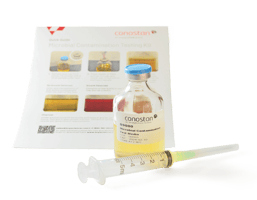Petroleum hydrocarbon contamination in water and soil is increasingly common around the world. This...
Tips for Preparing XRF Sample Cups for Petroleum Sample Analysis
Introduction
Petroleum is one of the top commodities in the world. During the refining process, petroleum is separated into distillates such as diesel fuel, jet fuel, lubricating oils, waxes, and petrochemical feedstocks. Through further processing, they can be used to make chemicals, plastics, and other synthetic materials.
To comply with environmental regulations and assure economic value, petroleum-based materials are routinely analyzed for the presence of elemental contaminants and sulfur-content. XRF is a commonly used analytical method for this application due to the techniques’ accuracy and long-term stability. Many of these analysis methods are detailed in ASTM methods such as ASTM-D2622, ASTM-D4294 and ASTM-D8252 Although sample preparation for XRF is simple, there are important best practices to assure the accuracy of analysis results.
Best Practices for XRF Sample Preparation
- Select a sample cup with appropriate size, depending on the XRF instrument.
- Select suitable window film material which is chemically resistant to sample contents.
- Choose a film thickness that provides the appropriate X-ray transmission and support.
- Avoid Contamination and wrinkles in the film in sample cup assembly.
- Single use, disposable cups are ideal to eliminate carryover between samples.

Selection of Cup Size
XRF instrument manufacturers design different apertures for sample irradiation. Some of the most common aperture diameters include 32, 40, 47 mm. The analyst should select the cup size that is compatible with the instrument and matches the sample holder and aperture chosen for the application method. The analyst should follow the recommendation of instrument manufacturer when creating an analysis method.
Selection of Film Material
The selection of the support film used for the analysis is one of the most critical choices when analyzing liquid samples by XRF. A poor choice can result in sample leakage and damage to the instrument, or insufficient sample signal from the analyte of interest.
The following criteria should be considered to select an appropriate window film:
- Chemical resistance.
- Sufficiently X-ray transparent.
- Low level of contamination for elements of interest.
Polyester, polypropylene, and polyimide are the most common materials for used for XRF support window film.
Polyester (Mylar®) has high tensile strength, so it is exceptionally durable, and can resist sample sagging or tearing. It is often used for analyzing sulfur in fuels, lubricants, and oils, but it is not chemically compatible with esters, aromatics, ketones, or aliphatic alcohols.
Polypropylene provides better transmission for both light and heavy elements than commercially available polyester films but has a lower tensile strength. Typical thickness is either 6 or 12 µm, and this slightly thicker film gives added security against accidental tearing of the film. It is an excellent choice for samples with low concentrations or light element analysis.
Polyimide (Kapton®) material is shiny orange/yellow in color. It is stable across a wide range of temperatures and is typically found with a 7.5 um in thickness. It can support almost any sample but is particularly affected by strong basic solutions. It is the best choice for samples containing high aromatic hydrocarbons, ketones.
Table 1. Summary of window film materials for liquid sample preparation
|
Material |
Thickness (µm) |
Characteristic Property |
|
Polyester |
3.0/6.0 |
Durable, good thin-film for general purpose |
|
Polypropylene |
4.0/6.0/12.0 |
Large transmittance |
|
Polyimide |
7.5/3.0 |
Good for high aromatic hydrocarbons, ketones |
Films should be made and stored under environmentally controlled conditions to avoid introducing trace levels of contaminants that might adversely affect the accuracy of the sample analysis.
The choice of support film should be based on the contents in petroleum products and the measurement objectives to ensure suitable chemical-resistance and proper thickness.
Sample Cup Assembly Practices
Sample cups commonly include two pieces, the open-end sample ring and the ring counterpart which is slightly wider than the sample ring. A film’s smoothness and cleanness are particularly important and must be maintained during cup assembly. As a result, one must avoid touching inside of sample cup and portion of window film. EasySNAP XRF thin film includes an easy-to-use frame that eliminates static cling and reduces the chance of touching the film unintentionally during cup assembly.
To avoid winkles in the film, place your selected film gently on top of the sample ring, then take the ring counterpart, press down onto the ring, gently but firmly. It should create a taut smooth film on the top of the sample ring. This needs to be as smooth as possible, as any wrinkles could affect the reading.
Finally, flip over the assembled sample cup, and carefully add liquid sample with pipette to a minimum depth or weight to achieve infinitive thickness for the element of interest in the matrix. Consult your instrument vendor for recommendations as this can vary based on XRF tube power, optics and diameter of the cup.
Summary
Analyzing the elemental content of petroleum products is routinely performed in fuel analysis and refinery laboratories for both regulatory compliance and quality control applications. Good sample preparation practices are critical to achieving the best results and preventing damage to the XRF instrument. The choice of sample cup and support film and assembly technique are all important to achieving optimal results.
References
- Oil revenue - Country rankings https://www.theglobaleconomy.com/rankings/oil_revenue/
- ASTM D2622 - ASTM D2622 Standard Test Method for Sulfur in Petroleum Products by Wavelength Dispersive X-ray Fluorescence Spectrometry
- ASTM D4294 - Standard Test Method For Sulfur In Petroleum And Petroleum Products By Energy Dispersive X-Ray Fluorescence Spectrometry
- ISO 20847 - Petroleum products — Determination of sulfur content of automotive fuels — Energy-dispersive X-ray fluorescence spectrometry
- IP 496 - Petroleum products - Determination of the sulfur content of automotive fuels - Energy-dispersive X-ray fluorescence spectrometry
- Sample preparation for XRF analysis of liquids https://www.malvernpanalytical.com/en/assets/PN12733_LE_SAMPLE_PREP_OF_LIQUIDS%20-%20FINAL%20%281%29_tcm50-71705.pdf




.png?width=50&name=MicrosoftTeams-image%20(1).png)

